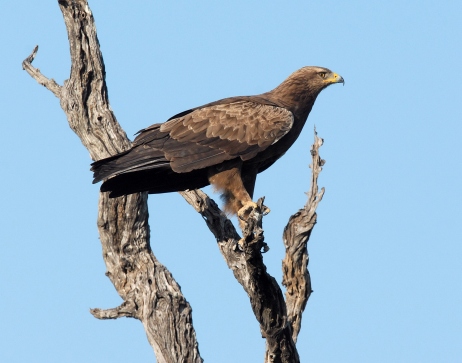This website provides information and advice on Birdwatching in eastern and north east Germany. The area covered is bordered by Poland in the east, and the Baltic sea in the north. This part of Germany includes Berlin, the surrounding State of Brandenburg, the State of Mecklenburg-Vorpommern and the Baltic Islands.
Trip reports and relevant publications are described.
Map of the area covered

East and North East Germany
This part of Germany is composed of two large States:
Brandenburg and Mecklenburg-Vorpommern.
The area has a rich diversity of birds, some of which are either rare to UK or are present in exceptional numbers. A summary of the breeding species and visitors of particular interest is as follows:
There are huge numbers of wintering geese. These are mainly Barnacle, White-fronted, Bean (fabalis and rossicus) and Greylag Geese. Flocks of 20-30,000 are regular. Most years one or two Lesser White Front and Red-breasted Geese are seen. The many lakes, rivers and polders attract a wide variety of duck and along the Baltic coast and the Baltic Islands are collections of sea duck in the winter, with Common and Velvet Scoter, thousands of Scaup, and hundreds of Long-tailed Duck, Smew and other sawbills. Also on the coast and the larger inland waters in autumn and winter are divers, particularly Black-throated Diver.
Common Cranes breed and thousands pass through on migration. Over 100,000 now roost at the main site close to Berlin.
In Brandenburg, quite close to Berlin, is the last remaining population of Great Bustards in northern Europe. Conservation measures have saved it from extinction.

Male Great Bustard (Heinz Litzbarski)
Raptors are well represented, with good numbers of White-tailed Eagle, and summering Osprey, Lesser Spotted E agle, Black Kite, Red Kite, and Honey Buzzard. Marsh Harriers are widespread. Rough-legged Buzzard, Merlin and Hen Harrier are regular winter visitors.
agle, Black Kite, Red Kite, and Honey Buzzard. Marsh Harriers are widespread. Rough-legged Buzzard, Merlin and Hen Harrier are regular winter visitors.
Both Pygmy and Tengmalm’s Owl occur but are very local
White Storks are widely distributed from the end of March onwards. Black Storks are more local., breeding singly in forests.
Above: Lesser Spotted Eagle (Bernd Meyburg)
Marshes, Lakes and Polders. Little Egrets are rare but Great Egrets are common in the autumn and winter. A few breed. Breeding in the polder areas are the three marsh terns. Black, Whiskered and variably White-winged Black Terns. There are good numbers of Corncrakes, Spotted Crake in the marshy sites and a few Little Crake. Bitterns are common. Little Bittern is more local. There a number of quite large colonies of Black-necked Grebe and Red-necked Grebe is a widespread breeder, often on the smaller stretches of water. There is good wader passage from July onwards, particularly along the coastal marshes. The spectrum of species is a bit different from UK. For example there are more Wood Sandpiper and Spotted Redshank and both Red-necked Phalarope and Broad-billed Sandpiper are regular in small numbers. However, other waders are fewer than are seen further west in Europe. Examples include Turnstone and Oystercatcher.
Other interesting breeding species in the wetland areas are Bluethroat, Thrush Nightingale, and the ‘wetland’ warblers – Reed, Great Reed, Sedge, Grasshopper, Savi’s and River Warbler. Common Rosefinch habitat is the bushy terrain along the polders and along the coast. Bearded Tit and Penduline Tit are widespread.
In the fields and hedges Ortolan can be found, particularly in Brandenburg, and where there are bushes, look for Red-backed Shrike and Barred Warbler. Also along the woodland edges and large gardens Icterine Warbler, Serin and Hawfinch occur. are More local are Hoopoe and Great Grey Shrike.
Within and around the forest areas are five woodpecker species, the most sought after being Lesser Spotted, Middle Spotted and Black Woodpecker. Wryneck occurs locally. Breeding in the damp woodland are Green Sandpiper. Beech forests are the favoured habitat of Red-breasted Flycatcher.
See Information page for guidance on where to see these species.
Roger White (March 2015) roger.white4@virgin.net
